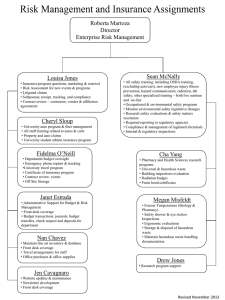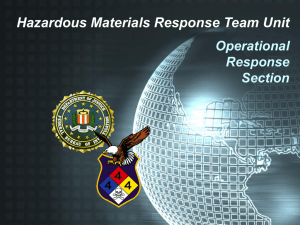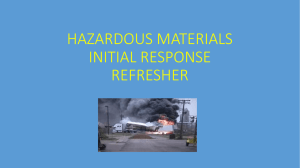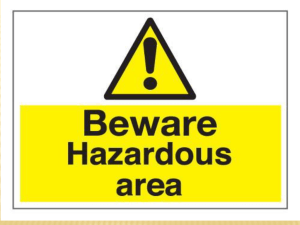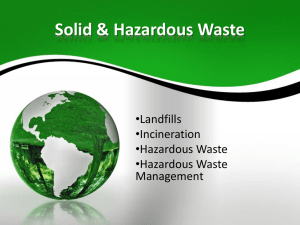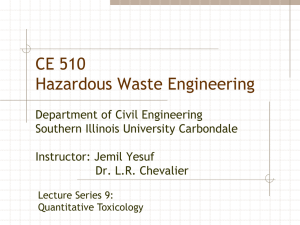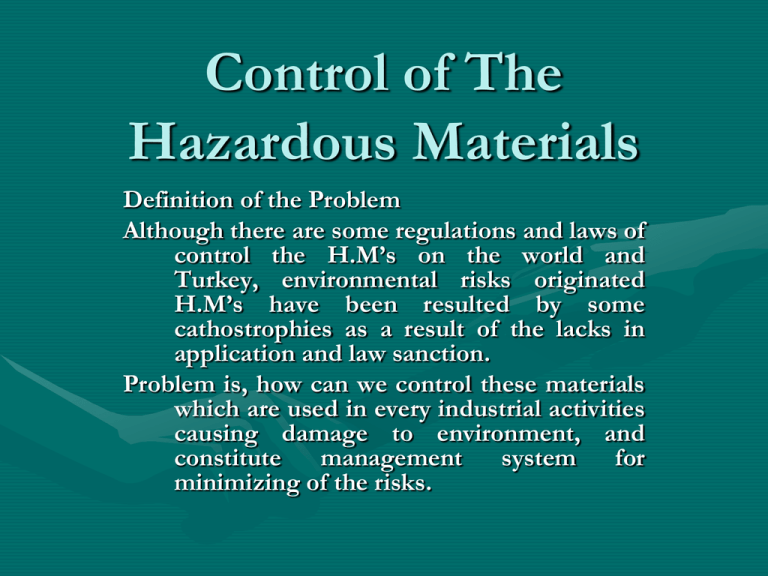
Control of The
Hazardous Materials
Definition of the Problem
Although there are some regulations and laws of
control the H.M’s on the world and
Turkey, environmental risks originated
H.M’s have been resulted by some
cathostrophies as a result of the lacks in
application and law sanction.
Problem is, how can we control these materials
which are used in every industrial activities
causing damage to environment, and
constitute
management
system
for
minimizing of the risks.
• Collection of the data on H.M’s and
information step are important to solve the
big part of the problem.
• For instance, in an emergency action step
during an accident, all informations about
materials causing the damage should be
known and an assessment should be done
with these informations for this situation.
Approach for solution to problem
•
Main aim of the course is assessment of
the risk and hazard which is exposured to
hazardous materials.
•
First HMs data is collected and than
evaluation, modelling, management or
emergency action plans are made
introduction
• Prior to the Industrial Revolution, disasters were
primarily limited to those caused by natural events
like floods, earthquakes, and volcanoes.
• While disasters still result from such causes
today, we are now confronted with others that are
relatively unique to the twentieth century.
• One such cause directly relates to the materials
used industrially to produce the amenities of
modern life by the chemical, petroleum and
nuclear industries.
• For instance, just consider one product of the
chemical industry, vinyl chloride.
• This raw material is used to make the synthetic
plastic PVC. As vinyl chloride is a highly
flammable substance, it has a severe fire and
explosion hazard.
• When released from its container, vinyl chloride
poses a substantial threat to public health and
safety. Bulk quantity of this substance are likely to
be encountered in the workplace during storage or
handling or during shipment.
• Vinyl chloride is a single example of a substance
that has come to be known as a hazardous material
where in general terms,
• a hazardous material is defined as a material with a
substantial potential to pose a danger to living
organisms, materials, structures or the
environment.
• Such dangers may consist of explosion or fire
hazards, corrosion, toxicity to organisms or other
detrimental effects.
• Hazardous materials may be found in a
variety of places even in the home.
• Some are found dispersed in the air we
breath; others are even in the food we eat
and the water we drink.
• In truth, hazardous materials are likely to be
found almost anywhere.
• One of the difficulties in dealing with the
hazardous materials is the variety of chemicals that
are found in our world today.
• The results of several studies show that there are
between 5 and 6 million chemicals and
formulations. A computer review of the total list of
Chemical Abstract Service indicated that 1.5
million of these chemicals were common, with
33000 to 63000 of them considered hazardous.
• To complicate matters, these “hazardous
chemicals ”are known by 183000 different names.
• These huge number of hazardous materials are generally
classified as follows:
• Class 1: Explosives (with 5 divisions)
• •Class 2: Gases (four divisions
• •Class 3: Flammable liquids (three divisions)
• •Class 4: Flammable solids; spontaneously combustible
materials; and materials that are dangerous when wet
• •Class 5: Oxidizers and organic peroxides
• •Class 6: Poisons and etiologic materials
• •Class 7: Radioactive materials
• •Class 8: Corrosives
• •Class 9: Miscellaneous
• and finally •ORM-D: Other regulated material
• For indicating and ranking the health,
flammability, and reactivity hazards of
hazardous materials, The National Fire
Protection Association (NFPA) has
developed a standard system (NFPA 704).
• In addition, a special precaution symbol
may be used where necessary.
• This system of identifying hazards associated with
various materials was developed primarily for fire
protection and emergency personnel but can be
useful to anyone who needs to handle potentially
hazardous material.
• As stated in NFPA 704, "This standard provides a
simple system of readily recognizable and easily
understood markings, which will give at a glance a
general idea of the inherent hazards of any
material and the order of severity of these hazards
as they relate to fire prevention, exposure, and
control".
• Hazardous materials may be acutely toxic or have
long-term chronic effects, even at low
concentrations. They include a large number of
organic compounds , and a number of inorganic
substances , heavy metals, for instance.
• Millions of kilograms of hazardous materials are
transported daily along the highways, railways and
waterways. Some of these materials, such as cyclic
pesticides, cyanide, organometallic compounds
and heavy metals are highly toxic to man and
environment , and the accidental release of even
small volumes of those materials to the
environment may have serious consequences.
• Accidental spills and releases of hazardous
substances can result from a variety of causes
including highway, rail, water, industrial plant
upsets, the failure of retaining dikes, storm
damage, malicious acts, and even air accidents.
• The cost of returning the environment to an
acceptable state following a spill may involve the
expenditure of millions of dollars, and even after
toxicants have been removed from a spill area,
undesirable effects may linger in the environment
for many months or years.
• Hazardous material spills may impair the quality of water,
land or air, or all three simultaneously.
• A land of spill of a non-volatile, toxic substance generally
has less impact on the environment than a spill of a highly
volatile, toxic substance or a substance that has entered a
waterway. Land spills can normally be contained and the
containment soil removed to a disposal area, localizing the
effects of the incident.
• Where air or water contamination is involved, the fluidity
of these media favor the transport of highly hazardous
substances over a wide area with possible dangerous
consequences. Once released to the atmosphere, vapor are
rapidly dispersed by diffusion and wind currents and
containment is possible.
• A community rating and evaluation system developed by
University of Western Ontario, Canada to find population
and environmental hazards in a community has been
described and a previous study conducted to find out the
index or an indicator of a toxic spill incident that might
happen in Bosphorus and its environment is evaluated.
• Rating values for that study were accounted for the
highway , railway, marine and pipeline transport plus the
industrial and storage handling of these materials.
• As a result of that study it can be said that the examined
area exceeds the limit values for the environmental hazard
rating and should be evaluated in the class of cities having
disaster potential.
• In the early 1970s, intensive efforts were started to
develop systems to meet environmental
emergencies.
• Before this time , the emphasis was placed on the
development of effective ways to identify
hazardous substances, to define physical hazards
associated with the handling of these substances,
and develop emergency first aid procedures.
• Starting in 1970, increasing attention has been
directed toward the environmental effects of
pollutants and the development of procedures to
prevent and cope with emergencies.
• The primary purpose of emergency plans is to prevent
incidents as well as to initiate timely, well organized
responses.
• When developing an emergency plan for a given area, it is
necessary to involve many agencies and personnel in the
creation of a network of facilities that must function rapidly
and precisely in the event of an emergency.
• It is of utmost importance that an accident be reported as
soon as possible and that effective actions follow for with.
• The spilled substance has to be identified, appropriate
personnel and equipment have to be rushed to the scene,
and the cleanup has to be accomplished without
endangering human life, while holding environmental
damage to a minimum.
• The 1996 North American Emergency Response
Guidebook (NAERG96) was developed for use by fire
fighters, police, and other emergency services personnel
who may be the first to arrive at the scene of a
transportation incident involving dangerous goods.
• It is primarily a guide to aid first responders in quickly
identifying the specific or generic hazards of the material(s)
involved in the incident, and protecting themselves and the
general public during the initial response phase of the
incident.
• The guidebook assists responders in making initial
decisions upon arriving at the scene of a dangerous goods
incident. It is primarily designed for use at a dangerous
goods incident occurring on a highway or railroad.
• All guides have been revised and are now presented in a
two (2) page format and identified by three (3) digit
numbers.
• Since many materials represent similar types of hazards
that call for similar initial emergency response actions, only
a limited number of guides are required.
• The orange-bordered guides are not applicable when
materials of different classes and/or divisions are involved
in an incident and are intermingled.
• Incidents involving more than one class of material require
the incident commander to obtain informed advice as soon
as the scope of the incident can be determined.
• Materials involved in an incident may, by themselves, be
non-hazardous; however, a combination of several
materials or the involvement of a single material in a fire,
may still produce serious health, fire or explosion hazards.
• In this study, a new approach shown in the figure
below is designed to manage the hazardous
materials .
• That approach considers environmental impact
assessment and environmental risk assessment
together. From the literature review it is seen that
there is a need to involve all components of the
environment not only man while managing
hazardous materials in our community.
• Some of the propositions made following this study are ;
• The control and response activities of hazardous materials
should use the same language as it is in traffic for instance.
• As our legislations are lack of enforcement not only
amendments should be made but also the institutions to
cope with the developments in this area should be
established.
• Hazardous material data sheets should be prepared for the
materials including the physical, chemical and biological
properties of the material, the response information in
terms of evacuation distances, fist aid, protective
equipment etc.
• Figure . Basic considerations in hazardous
material management
• Rapor son 7 Figure( T M Kitap)
Information
•Descriptions
•Properties
•Classification
•Potential Hazards
Forbid production and
distrubition
Risk Estimation
•Explosives
•Corrosivity
•Toxicity
•Radioactivity
•Flammability
•Infectious
•Carcinogens
•Contamination
Environmental Area
Inventory
•Population indexes
•Settlement
•Social Life
•Industry
•Climate
•Jeology/Hydrogeology
•Flora/Fauna
Environmental Standarts
Environmental
Protection
Forbid production and
distrubition
Incident Shipment
User Exposure
Food Chain Distribution
•Prevention
•Preparedness
•Response
•Recovery
Figure . Basic considerations in hazardous material management
HAZARDOUS MATERIALS
• Cathastrophies before industrial revulation are
limited commanly by storms,eartquikes,volcanies
etc.
• Novadays additional disasters occur , reason of
HMs from especially chemical, petrolium and
nüclear industries.
• Numerious tons of the HMs are transported with
highway, railway, waterway and pipelines and 10%
of commerce of the world has been calculated on
these materials.
• Commanly used HMs are pesticides, cyanides,
organometalic compounds and heavy metals and
these materials are known as highly hazardous
even at small amounts to human health and
environment.
An example
• Destroyed aquatic life in Ohio Shawnee Lake:
• An angry man who has not been permittted to swimm in
the lake throws to lake a bottle including 700 gr endrin
(after event forbidden pesticide).
•
Concentration in lake water reaches 7 ppb (per billion) and
100 ppb in lake sediments, all fishes and aquatic life are
destroyed by high toxicity.
• For Endrin Fish Toxicity Value is 0.2 ppb and safty limit
for human is 1 ppb dir. Half life of the Endrin is given as 720 year in literature (ZAJIC ve HIMMELMAN, 1978).
• Above example is very important to recognize on HMs
according to limits.
• Table 2-1
Accident and cathostrophies in period 1959-92
Year
Place
Event
Damages
1959
Minamata bay, Japan
Mercury discharge to river
400 death, 2000 injuries
1973
Fort Wayne, USA
Vinyl choloride
accident.
1974
Flixborough, UK.
cyclohexanon
explotion
1976
Seveso, Italy
Dioxin leaking
193 injuries, 730 evacuation
1978
Los Alfaquez, Spain
Propylene spill in transportation.
216 death, 200 evacuation
Xilatopec, Mexico
Gas tanker explotion in highway.
100 death, 150 injuries
Manfredonia, Italy
Ammonia leak in an industry
10000 evacuation
Threemile Island,USA.
Nücleer reactor accident
200000 evacuation
Novosbirsk, Russia
Explotion in chemical industry
300 death
Mississagua, Canada
Cholorine and butane relased to
environment by train accident.
200000 evacuation
Summerville, USA
Phoprous three choloride spill in
railway
300
injuries,
evacuation
Barking, USA
Hydrogen cyanide relased in
industrial fire
12 injuries,3500 evacuation
1979
1980
spill
occured
in
train
in
an
4500 evacuation
23 death, 104 injuries 3000
evacuation
numerous
1981
Tacoa, Venezuella
Oil fire and explotation
1982
Taft, USA.
Patlamada kimyasallardan
17000 evacuation
acrolein relased in chemical
fire
1984
Sao Poulo, Brasil
Explotion in oil pipeline
508 death
St. J.Ixhuatepec, Mexico
Gas tank explotion
452 death, 4248 injuries,
300000 evacuation
Bhopal, India
Cyanogen gas leak from 72500 death,
Pesticide industry
evacuation
Chenobyl, Russia
Nüclear reactor accident
725 death, 300 injuries,
90000 evacuation
Basel, Swiss
Fire in Pesticide industry
Pollution in Rhein river
1987
Kotka, Finland
Monochlorobenzene spill in Pollution in deep sea
dock
1991
Gulf war in , Basra Bay
Petrolium discharges
Sea pollution
1992
Alaska
Petrolium spill
Sea pollution
1986
145
death,
evacuation
1000
200000
• There are 5-6 million chemicals, compounds and
formulation according to CAS.
• In Chemical Abstract Service(CAS) lists, It is
estimated 33,000- 63,000 number of HMs and 1.5
million chemicals are commonly used in our life.
• These materials are known 183,000 different names
and it makes their management more complex and
diffucult (ERICKSON at all, 1989).
HM’s hazards
• HMs react with another material and a /any
new toxic material may occur.
• Cholorine gas may occur with a fast reaction
when acidic commercial detergent and pond
disenfectants are combined or mixed.
• Cholorine gas is highly hazardous, If it is
inhalated to human body because tolarable
limit for human health is 1 ppm.
• HMs may be changed interactive form by heat.
• Oxidants easly reacts with flammable materials
and auto-ignition may occur.
• For example; concentrated nitrik asit is an oxidant
and if it spills on fine heap of trash, sufficient heat
occurs for ignition of trash itself (e.g auto-ignition
).
Properties of Hazardous Materials
• Hazardous materials safety data sheet (HMDS)
contains 3 main parts; Where
• Phsycal properties and hazards
• Chemical properties
• Biological properties and life hazards
• Important properties of HMs are solubility,
density, flammability, corrosivity and rectivity etc.
–
Solubility
•
It defines generally as a material which
occures a solution of %10 with water.
•
If 250 ml of an organic material is not dissolved
in 1.5 gallon (5.67 l), it is not accepted as soluble
for a fireman
•
Above definition is not scientific definition of
solubility but is practical for fireman to
immediately decide during a fire
•
•
• Density
Simple definition is mass of material per unit
volume. Second definition is specific gravity,
ratio of densities of a solid or a liquid to WATER
density. This ratio is dimensionless and shows
density relation between water and material .
Specific gravity = Material weigth/ water weigth
in equal volume of material
• It is important to know specific gravity of a material during
a fire because we can decide to use water.
• Imagine that a fire in a tank including insoluble liquid with
water and specific gravity less than 1 such as oil , if fire man
interferes with water , fire will releas and lies because water
will settle to deep and oil will be overflowed to out of the
tank
• Contrary situation (specific gravity >1 liquid) fire can be
finished by water. Figure 2.2
• Against to specific gravity of liquid and solid, most
important physical property is vapor density for
gases and vapors . Ratio of gas or vapor density to
air density (1.29 gr/lt) is generally used.
• Vapor density (X) = X ‘s density/ air density
• If the ratio is bigger than 1, vapor will settle but
less than 1, vapor or gas will rise in air.
• Dog inns (CO2 from lime stone)example may be
given.
• For calculation of the ratio, air and vapor molecular weigth
must be known. Air molecular weitgh is 29 and cholorine
gas MW is 71, where chlorine vapor density is calculated as
71/29=2.49 . 2.49>1.29 and gas is weigher than air and gas
will settle in air.
• This ratio is 0.59 for ammonia and the gas is defined as
flaying gas in air. Whereas ammonia is dissolved with
humudity in air and it dissolves in %51 ratio and produces
immediately ammonium hidroxide (NH4OH) . MW of this
new material 35 g/ mol and bigger than air ,so relased
ammonia in air will settle.
Flammability, ignitability
•
Another hazard criterium for HMs is
flammability. A HM may occur a flame and
produces gases and vapors by ignition source.
•
Flammability limits are given as follows;
• Lower Flammability Limit : minimum conc of gas or vapor in air which
can be occured flame when it ignites. The value is volumetric percent
of gas in air.
• Upper Flammability Limit : maximum conc of gas or vapor in air which
can be occured flame when it ignites. The value is volumetric percent
of gas in air.
• Flush Point : temperature of a liquid when it is ignited which can be
shown a flame or vapor on its surface.
• Auto-ignition Point: temperature of a vapor or gas which can be
flammed unless an ignition source.
• Vapor Pressure: Presure of a vapor equalized with liquid at certain
temperature. Dimension is usualy given mmHg (760 mmHg = 1 atm. at
sea level).
• Boiling point : temperature of a liquid at occuring of vapor bibles from
surface of liquid to atmosphere . At boiling point in a open cup, vapor
pressure is equal to atm. pressure.
• In practice all reactions take place in exothermic or
endothermic conditions. However reaction must be
reached to sufficient energy level which is known as
“activation energy”.
• Generally an arc or ignition may be enough to reach this
level of“activation enerjgy” .
• Activation energy level for a reaction is shown in Figure 0-3
• Rapor son 7 sayfa 37
• Corrosivity
•
•
•
Corrosive materials are defined as;
A material is capable to thin out a metal in
contact or damage to human skin in touch.
They may be in forms of solid, liquid and
gas and are known as acids and bases.
•
• Peroxides and reactivity
This property is considered as instability or
incompatability of a pure material or specific group.
•
Peroxides is main group and their main form is peroxo
group(-O:O-) in compounds.
•
For example hydrogen peroxide (H-O:O-H) is commanly
known and used. General formula is R-O:O-R.
• Reactivity is related with a/any material may
capable to react with others.
• It is shown as symbol of W by firemen and it
shows a strong reaction with water in NFPA 704M
plackard system.
• In practice, it means of material is degradable in
contact with water and resulted by a hazardous
chemical reaction.
• For this reason , these materials are defined as
“reactive with water”.
•
•
Toxicity
Toxicology is defined a scientific branch searching
on poisonous effects of chemicals on biological
systems.
•
All chemicals may be poisonous or toxic when they are
taken in certain dosage and certain exposure time . Even
Oxygen may be reason of irritation when it is taken in
over dosage.
•
Toxicity appears with undesired situation or a damage
which may be in forms of irritation, sensitivity, damage in
organs, cancer, allergical symptoms etc. They may be
temporary or permanent in local or systemic organs.
• Local toxicity : skin eruption, leison and spots or
fester in skin are examples for local toxicity.
• Systemic toxicity : effect can be dispersed in a
system living body such as blood or lymph system.
Poison may enter from a point but effect may
diffuse all body.
•
• Liver,thyroid,kidney or lung may be targeted end
of the effect. Anesthesics, narcotics, nitrates and
CO(cabon monoxide) are example of systemic
toxicants.
• Appeared effects in daily(24 hours) exposure are known as
acute effects. Acute effect is usually realized at shorth time
exposure with moderately to high dosages. Observed
symptoms are irritation in eyes, nose and throat,
temperature, red spots in skin, headache, nausea, vomiting
and even death. Mostly acute effectst are temporary.
• Effect occured with long term exposure to a chemical is
known as chronic effect . The effect is usually permanent
and it occurs at long time exposure to low concentration or
dosages.
• Chronic effects may resulted by liver or kidney damages,
cancer, deformative births and mutagenity. Long term
exposures may be years. E.g. A carcinogenic material
(carginogens) effects may not be observed through 20-30
years.
• Central Nervous System (CNS): Some materials may also
effect CNS additional to some organs CNS.
• CNS contains brain, spinal cord and main nervous system .
Amnesia (loss of memory)and paralysis symptoms may be
observed when CNS is inpressed or excited.
• For example, when intaking of a somnolent drug, warning
of no driving must be made.(loss of movement).
• Dose-response graphs : Toxicologists measure the toxicity
of a chemical by range of different dosages in tests on
animals such as hemmisters, rabbits and rats. It means to
similar effects on human. Dose-response graphs are drawn
with certain dosages vs effects . Behaviors of test
population are determined according to higher chemical
dosages . Typical dose-response graph is shown in figure
0-4 . Book pp. 45
• Generally there is a dosage which could not be observed in
graphs, this point is known as treshold values and it is first
dosage can be observed first response and in this situation
response is mortality. At the lowest dosage, there is no
mortality and at higher dosage test animals may be sick but
no die.
• Hatta gözlem periyoduDoz (mg/kg)Tepki
• (kümülatif % ölümler) 10050AB
•
Şekil 0-4 Doz-tepki eğrisi
• boyunca ölüm olayına rastlanmayan dozlar bile
olabilir.
• Greater toxic effect is observed when in higher
dose. LD50 is defined as lethal dose which is died
%50 of test species .
• LD50 usually is given as dose per kg body weigth. .
• Relative toxicity values can be calculated by LD50
values of different chemicals.
• LD50 will be higher for species of weigher body.
• Doz tepki eğrileri verilmeli
• As shown in figure 2-5 two dose-response graphs intersect.
C chemical has a lower LD50 value than D . However D
which has lower LD20 value is more toxic than C at lower
dosages and It will be reason of mortality before C.
• On the other hand, LD50 dosages are given as oral intake
or injection whereas inhalation is more effective than others
in toxicity events.
• Factors effected for human response:
• Although all materials may be toxic all peoples may not
given same response to same material. There are some
factors for human.
•
•
•
•
•
•
Genetic character
Mode of intaken to body
Sex
Age
Chemical interactions
Dose ratio
• Mode of intaken to body ;
•
•
•
•
Directly touch or skin contact
Inhalation
Oral intake
Injection
• In emergency situation, inhalation and oral intake
are more dangerous than other.
Chemical interactions:
• There are 4 interaction when 2 or more chemicals take
place in toxicity :
• Cumulative interaction: Total effect is sum of all
induvidual effects. If anybody takes one unit of each
material , total effect is 1+1=2.
• Sinergystic interaction : synergysm means a higher effect
than cumulative effect. Two or more toxic material create
higher effect than sum of induvidual effects. For example
(1+1=10) smoking and alcohol create more adverse effect.
• Potantial interaction: a material which may be active as
toxic and non active material may create higher toxicity
than alone. Their interaction is resulted with (1+0=5).
• Antagonistic interaction : toxic effect of a material may be
decreased with another material (1+1=1/2 or zero).
• Dosage:
• An acut effect of a material is related with exposure time
near dosage.
• E.g. An adult drinks whiskey of 1.5 ons (42.5 gr) every
morning and also 1 ons (28.3 gr) every afternoon thorough 1
month , he/she utilizes totally 90 ons (approx. 2.5 kg
whiskey)
• A ligth headace may be felt in every day but amount of
whiskey of (0.75 galon = 2.84 lt) is utilizes at 1 hour period
probably death is realized. Exposure time is basic funtion
of dosage.
• This function can be explaned by a process which
is known as biological tolarence.
• This process is ratio of removing (discreate) of
toxic material from body.
• If dose is more less than ratio of biological
tolerance, toxic effect will be at the lowest level in
body.
• Contrary toxicity realizes in body and additional
damages occur.
• Permisible exposure limit (PEL) is used only by
OSHA (occupational safety health. However it is
not appropriate for protection of pregnant, sick
and older people.
•
• Quantific value of PEL is similar to TLV-TWA
(treshold limit value-time weigthed avarage) but is
not equal. PEL and TLV-TWA are given in
HMSDS for most materials.
• TLV-TWA values are given by ACGIH and they present a
concentration beliving to protect of labor which is worked
not to exceed 5 days per week and 8 hours per day exposure
period.
•
These values are not also protective mean for sick,
pregnant and olders. TLV-TWA values are usually used as
cumulative effect for than one materials. For example, if
there is 80 ppm xylene and 30 ppm toluene at 8 hours
avarage and inhalation level, TWA value is calculated as
follows;
•
•
•
•
•
TLV-TWA (xylene) = 100
TLV-TWA (Toluene) = 100
Xylene concentration is 80/100 of TWA .
Toluene concentration is 30/100 of TWA .
Cumulative value is = 0.8 + 0.3 = 1.1
• The value is bigger than 1 but TLV-TWA value can not be
> 1 and it is accepted 1.
• TLV-Cel is upper limit as concentration which is not
exceed at any time of work.
• TLV-Stel is known as concentration of short time exposure
limit and may resulted by irritation, sleeping or cell
damage.
• In this situation, maximum 4 break or refreshment should
be given which is not less than 15 minutes of each and 60
minutes among them.
Risk Assessment
• Risk;
• Risk is defined as probability of a/any negation or
undesired event in certain conditions. Risk can be
realized by two constituents:
• Probability of a/any negation or undesired event
(specific sickness or injuries )
• Results of negation or undesired event(damages)
• Risk includes effects on environment and human
and it appears with situation of unprotected or
faith. There is no risk, if it is not exposured to an
undesired event or a material.
FROM:
•Site Discovery
•Preliminary assessment
•Site inspection
•NPL listing
Data
Collection
Toxicity
Assessment
Data
Evaluation
Risk
Characterization
Exposure
Assessment
TO:
•Selection of remedy
•Remedial design
•Remedial action
Data Collection
•
•
•
•
•
•
•
•
Collect existing data
Address modelling parameter
Collect background data
Collect preliminary exposure assessment
Devise overall strategy for sample collection
Examine QA/QC measures
Identify special analytical needs
Take active role during workplan development and
data collection
Data Evaluation
• Combine data avalible from site
investigations
• Evaluate analytical methods
• Evaluate quantitation limits
• Evaluate qualified and coded data
• Evaluate blanks
• Evaluate tentatively identify compounds
• Compare site data with background
• İdentify chemicals of potential concern
Exposure Assessment
•
•
•
•
•
Characterize physical setting
Identify potentially exposed populations
Identify potential exposure pathways
Estimate exposure concentrations
Estimate chemical intakes
Toxicity Assessment
• Gather qualitative and quantitative toxicity
information for substances being evaluated
• Identify exposure periods for which toxicity
values are necessary
• Determine toxicity values for
noncarcinogenic effects
• Determine toxicity values for carcinogenic
effects
Risk Characterization
• Review outputs from toxicity and exposure
assessments
• Quantify risks from individual chemicals
• Quantify risks from multiple chemicals
• Combine risks across exposure pathways
• Assess and present uncertinity
• Consider site-specific human studies
• Risk analysis is a detailed investigation including
risk assessment, risk recognation and risk
management alternatives. Appearing of undesired
results to environment, human health and life is
aimed.
•
• It is an analytical process firstly collecting of data
and quantific evaluation is made for estimated
risks and their expected results.
• Risk assessment is a process to appear an
information on acceptable risk level for indivudual,
group, community or environment.
• Risk estimation is adequately a scientific and
quantific determination of risk characteristics.
• Characteristic of the risk include size, time, level
of damage and also related probabilities .
• Risk recognation is a evaluation step of decission
on acceptable risk and its importance.
• Compable risks are a comparison of two or more
risks related with similar actions. It can be
quantified or qualified by a/any ratio or terms
such as bigger than others, moderately or low. A
comman scale is used for this comparison.
• Specific source of risk is ratio of disaster appearing
with certain event or specific material. This ratio is
difference between rate of exposed the risk and not
such as accident or death rate.
• Environmental ımpact assessment (EIA) is a study
to appear negative or positive effects of a proposed
activity on environment . It also presents similar
alternatives and gives all data to decissionmaker
as positive or negative. In other words, EIA is a
budget for an activity vs environment.
• Danger;
• A situation or condition which has a potantial
negation to life or organs.
• Damage;
• is a situation of physical, functional or negation
when danger is uncontrolled .
FUNCTIONS OF RISK ASSESSMENT RATIO (RAR)
• RAR is a model for assessment of environmental risk and functions of
•
•
•
•
•
•
•
•
•
•
•
•
•
•
Environmental risks;
Tö:HM properties
S: solubility
D: density
F: flammability
C: corrosivity
RP: Reactivity and Peroxides
Tox: toxicity
ECOT: Eco-toxicity
ht: toxicity to human health
MKM: mode of exposure to HM
Tt: Transportation of HM
K: HM accidents
Q: amount ofHM
• Eö: Ecosystem specifications
• BS: Boundry of region
•
•
•
•
•
•
•
YFK: life, activity, beneficial uses
Urbanization
Industrial
Agriculture
transpotation
Tourism and recreation
Strategic
•
•
•
•
•
•
ÇK: environmental sources
Water and watershed
Forests
Terrestrial ecosystems
Flora-Fauna
Density of human Population
equations
• RA = f (TÖ, EÖ, Q)
• RA = (EÖ + TÖ) x Q
(1)
• RAR =(EÖ + TÖ) x Qi / (EÖ + TÖ)max x Qmax x 100
• (EÖ x TÖ)max x Qmax, max values of constituents in table
(2)
TEHLİKELİ MADDE ÖZELLİKLERİ: (Tö)
• Physical and chemical properties and
hazards (FKsp)
• Biological or life hazards and properties (BT)
• Tö = (BT + FKsp)
(3)
•
• FKsp=S+D+F+C+PR+Tox (4)
•
• Solubility: S
•
•
•
•
•
•
•
•
is defined as usually occuring of %10 solution in water;
Solid material in water
> %10 solution
1
< %10 solution
2
liquids
if material/water = 0.05
1
< 0.05
2
> 0.05
3
<< 0.05 and egsothermic reactions
4
Gases are ignored.
• Density: D
• Specific gravity is important
• For liquids
sp. G. < 1
2
•
Sp. G > 1
1
•
• Exothermic liquids are ecxept such as sulphuric acid
•
•
•
•
For gases
vapor density.> 1.29
2
For gases
vapor density. < 1.29
1
hygroscopic materials such as amonnia and density >= 1.29
50 points is taken
• flammability: F
• F = (f)n
• Table 1. flammability values
(*)
f.
Flush point < 60 °C
4
60 – 90
3
90 – 120
2
> 120
1
• (*) It should be determined with ASTM standard D-3278 test method
• (**) Upper limit is taken for explosives. Eg. Dynamite is solid and evaluated
with 4 points.
• n=1
for gases
• n = 0.75
for liquids
• n = 0.50
for solids
• corrosivity: C
• C = (c)n
• Table 2. corrosivity values
Corrosivity (*)
C
> 6.35 mm/year
4
6.35 – 3.17 mm/year
3
3.17 – 2 mm/year
2
< 2 mm/year
1
• (*) NACE (National Association of Corrosion Engineers) Standard TM-01-69
is methodology for test.
• n=1
for gases
• n = 0.75
for liquids
• n = 0.50
for solids
• Peroxides and Reactivity: PR
• PR = (pr)n
• Table 3. Reactivity values
r.
Instable-highly rective
4
Reactive with water
3
At pH=2.0, pH=12.5
produces cyanide and
2
sulphide gas
Explosive contact with
1
water
• n=1
• n= 0.5
for liqud and gases
for solids
• toxicity: Tox
• Tox = (ECOT + ht) k
k = 1 if carsinogenic
•
k = 2 if non carsinogenic
• Where ;
• ECOT presents ecotoxicity and ht presents human health toxicity.LC50 , LD50
and TLV values are based on for ecot and ht subsequently.
• Ekolojik Toksisite: ECOT
• ECOT = (ecot)n
• Table 4. toxicity values(n = 1 for liquids, 0.50 for gases and 0 for solids)
LC50
t.
< 0.1 mg/l
4
0.1-10 mg/l
3
10-100 mg/l
2
>100 mg/l
1
• Toxicity rating: ht
• The rating is positive number 1 to 6 producing by ht in
HMSDS table using LD50 and TLV values. The lowest
degree is 1.
•
•
•
•
•
•
1. degree
2.
3.
4.
5.
6.
1 point
2
3
4
5
6
• Carsinogenity can not be quantified and if it is known
cancer risk for a material , ECOT and ht values are
multpled by 2.
• Biological or life hazardous properties: BT
• BT is recognized as cumilative value of MKM, Tt
and K .
• BT = MKM + T + K
(5)
• Mode of exposure to HM : MKM
• There are main three modes;
• Table 5. MKM values
MKM modes of exposure
Poin
t
Skin Contact
1
Oral Intake
2
Inhalation
3
• Transportation of HM:Tt
• There are 4 main transportation modes.
• Table 6. Transportation modes
Transporttation modes
Point
Sea water way
4
highway
3
railway
2
pipeline
1
• HM accidents: K
• Damages from accidents are function of HM
potantial hazard and also accidental potantial of
transportation modes. However accidental risks
should also be evaluated during usage of HM. For
this reason, storage, industrial usage and usage in
life of HM should also be included as additional
risks. Where US is usage mode and equation;
• K = Tt x US
(6)
• US = 3
factor of social usage
• US = 2
factor of industrial usage
• US = 1
factor of storage
• US factor is equal to storage factor for pipelines.
• Quantity, amount of HM: Q
• Amount of HM is a function of risk potantial. For
example there are deferences between spilled 1 or
1000 tons of oil in sea. Ultimate concentration in
water body can be estimated by amount of spilled
oil.
• Amount factor is postulated in equation as
multiple of other effects of Tö and Eö.
• Q > 1000 tons
4 points
• Q = 1000 – 500 tons
3.5 points
• Q = 500 – 100 tons
3 points
• Q = 100 – 1 tons
2.5 points
• Q < 1 ton
2 points
• Ecosystem properties :EÖ
• Region which is exposed to risks is
evaluated by boundries, ecology, life
activities and usage of ecosystem. Sum of
these constituents are postulated as
functions of the ecosystem characteristics;
• EÖ = BS + ÇK + YFK
(7) where;
• BS = boundry of region
• YFK = life, activities and usage modes
• ÇK = environmental sources
• Boundry of the region: BS
• Dimension of region boundry is usually km² and surface of site is
estimated for relaesed HM . Spilled or released site or area is more
important than region boundry.
•
•
•
•
Area > 100 km²
Area = 100 – 10 km²
Area = 10 – 1 km²
Area < 1 km²
10 points
5 points
3 points
2 points
• Pointing is made by boundry region according to distrubution of HMs.
•
•
•
•
Area > 1000 km²
Area = 1000 – 100 km²
Area = 100 – 10 km²
Area < 10 km²
10 points
5 points
3 points
2 points
• On the other hand, if estimating of risk is made for transportation,
transfer time and line long are considered.
• Transfer line > 1000 km
10 points
•
1000 – 100 km 5 points
•
<100 km
2 points
• Life, activities and usages: YFK
• This constituent is postulated as cumulative evaluation for
beneficial uses of the environment. Quantifying of ecosystem
characteristics is very diffucult but it can be done by increasing
values for each values especially in EIA.
•
•
•
•
•
•
Urbanization:
Country sides on main transfer lines
Cities
Small industrial cities
Big or organized industrial cities
Metropolles
•
•
•
•
•
Industrial:
Organized industrial estates
Estates including 10 – 100 number of SMSI
Estates including 1 - 10 number of SMSI
(*) SMSI: small and medium size industry
2p
4p
6p
8p
10 p
10 p
5p
2p
•
•
•
•
•
•
•
•
•
•
agricultural:
1. class earth for agriculture
Transportation:
Sea and water way
railway
highway
if ratio > %50
if ratio< %50 ise
10 p
5p
10 p
5p
2p
(*) airway should be evaluated 10 points if region has an airport in
international satandard.
• (**) if there are all modes in region composite weighted avarage points
may be taken.
• (***) points for pipeline is equal to railway.
• (****) in situ pases of waterway, highway, bridges and under ground or
undersea tubes are evaluated by the highest point.
• Tourism and recreation:
• At least one touristic area in region is evaluated 10 points. Recreational
such as picnique, fair or natural areas are 5 points.
•
•
•
•
•
Strategic:
High degree strategic uses such as official or army restricted areas 10 p
Restricted official areas
5p
Official training areas
2p
•
•
•
•
•
•
•
•
•
•
•
•
Environmental sources (ÇK):
Following constituents are evaluated.
Water and Watershed:
In the region;
Existing lake aimed for drinking water 10 puan
Water source for usage water
8 puan
Water source for irrigation water
6 puan
Waters aimed recreation
4 puan
Blackish or salty waters
2 puan
(*) sea water open to beneficial uses in the region at least line of 20 km
and 2 km continental shelf are evaluated 10 points.
• (**) gulf, bay and missellanous sea ecosystems are also evaluated 10
points.
•
•
•
•
•
•
Forestery areas:
If at least forest %10 of the region ;
1. class forest area
2. class
3. class
Undefined areas as forest
10p
8p
6p
4p
• Terrestrial areas:
• air, water, solid, earth, soil, flora, fauna and populations of ecosystem
are evaluated.
•
• Flora-Fauna:
• If determined endemic species number is bigger than 1 and protected
by law
• 10 points
• Population Density for Human:
•
> 2000 capita/km²
10 p
•
1000-2000 capita/km²
8p
•
500-1000 capita/km²
6p
•
100-500 capita/km²
4p
•
<100 person/km²
2p
•
• RAR values as percent producing by model can be ranked
in a scale. Scale shows 4 sensitive and risky areas and 1
treshold of the risks in figure 5.1.
EXTREME RISK
•Sensitive Areas Very Rich in Environmental
Resources, Very Poor in Tolerance.
•Restriction in Hazardous Material Usage and
Exposure Times should be Minimised
•Extensive Emergency Planning in Environmental
Protection Context
HIGH RISK
•Tourism Areas Rich in Environmental Resources,
Poor in Tolerance
•Exposure Times to Hazardous Materials should be
Reduced
•Emergency Plan should be Prepared
100 %
80%
79 %
60 %
59 %
50 %
THRESHOLD VALUE
•Areas Critical in Environmental Resources and
Tolerance
•Activity Zones are Included
•Threshold, Median Values in Risk Assessment
40 %
39 %
LOW RISK
•Areas Rich or Poor in Environmental Resources, Rich
in Tolerance
•Industrial Regions where Exposure Times to
Hazardous Materials should be Controlled
20 %
19 %
ACCEPTABLE RISK
10 %
9%
NO RISK
0%
•Areas Poor in Environmental Resources, Rich in
Tolerance
•Industrial Regions Controlled by Plans
•Areas Poorest in Environmental Resources
•No Ecological Value
ESTIMATION of IMPACT ZONE
27,4 m
0,2 km
0,3 km
Attached files as case studies
• Volgoneft italy oil spill-ppt
• Ufuk acrylonitrile paper -ppt
• Placards hm
Midterm exam- Team works
•
•
•
•
•
•
•
•
•
•
Acrylo-nitrile
Vynile-chloride
1,1,1. Trichloro ethylene
Chlorine
Amonnia
Cyanide
Mercury
LPG
Petroleum
Asbestos



